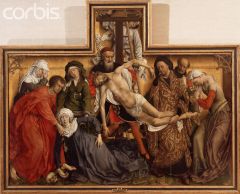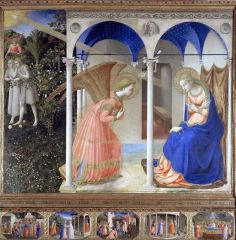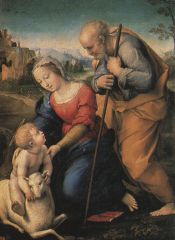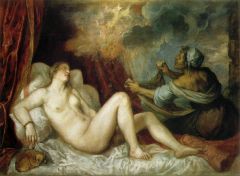![]()
![]()
![]()
Use LEFT and RIGHT arrow keys to navigate between flashcards;
Use UP and DOWN arrow keys to flip the card;
H to show hint;
A reads text to speech;
32 Cards in this Set
- Front
- Back

Name/Date/Style/Artist
|
The Chapel of Maderuelo/ 12th century/ Romanesque/ anonymous
|
|

Name/Date/Style/Artist
|
The Descent/ 1435 (Early 15th Century)/ Flemish (International Style)/ Rogier van der Weyden
|
|

Name/Date/Style/Artist
|
The Annunciation/ 1430 (Early 15th Century)/ Early Renaissance/ Fra Angelico
|
|

Name/Date/Style/Artist
|
Sacred Family/ 1507 (Early 16th Century)/ High Renaissance/ Rafael
|
|

Name/Date/Style/Artist
|
Bacchanal/ 1519/ Venetian (High) Renaissance/ Titian
|
|

Name/Date/Style/Artist
|
Danae/ 1555/ Venitian (Painterly Painter) Renaissance/ Titian
|
|
|
How was perspective used in the Romanesque period?
|
No depth representation; hierarchic perspective; inverted perspective
|
|
|
How was perspective used in the Gothic period?
|
Hierarchic perspective; used inverted perspective and began experimental perspective without scientific theory
|
|
|
How was perspective used in the Flemish period?
|
Good representation of depth and landscape; better than Gothic but still not perfect because they lack theory
|
|
|
How was perspective used in the Early Renaissance?
|
Linear perspective utilizing structural lines
|
|
|
How was perspective used in the High Renaissance
|
Perfect linear perspective without structural lines
|
|
|
What is hierarchic perspective?
|
Most important figures represented in largest size
|
|
|
What is inverted perspective?
|
An early attempt by Romanesque, Gothic, some Flemish, and some early Early Renaissance artists to create the illusion of perspective before linear perspective; also known as Byzantium perspective
|
|
|
What is linear perspective?
|
The mathematical theory put forward by Brunelleschi in the Early Renaissance to create the illusion of depth by utilizing a unique vanishing point to which all objects receded
|
|
|
How was perspective used in the Mannerist period?
|
Some painters used it, and some did not; eventually all figures are shown in the foreground and the background in unimportant
|
|
|
What is atmospheric perspective?
|
The technique of creating the illusion of depth by changing the contrast between the foreground and background gradually over a landscape
|
|
|
What is chiaroscuro?
|
It is the use of light and shadow over figures and objects to represent volume using different color tones
|
|
|
What is Hermetism?
|
It the abandonment of a widespread cannon in favor of one shared in secret between a select group of individuals; the name comes from the Roman god Hermes, the god of health and secrets
|
|
|
During what time period was the Renaissance?
|
15th- mid 16th centuries
|
|
|
During what time period was the Gothic era?
|
During the 13th - 15th centuries
|
|
|
In what area was the International style began?
|
Flanders (southern Netherlands and northern Belgium)
|
|
|
Why was there conflict between Micahelangelo (Rome) and Titian (Venice) in the 16th century?
|
Michelango was a staunch believer in drawing, structure, and precision, whereas Titian, as a painterly painter, favored free quick brushstrokes, without much form
|
|
|
Who was the creator of oil paint?
|
Jan van Eyck in Flanders during the early 15th century
|
|
|
What is sfumato?
|
The mixing of different colors to add softness and smoothness over surfaces and volumes
|
|
|
What types of colors did mannerists generally use?
|
Mannerists usually used unreal secondary colors such as pastels and pale tones
|
|
|
What is conceptual art?
|
The disregarding of intellectual art; it does not mind nature; it only seeks to convey ideas, mainly to the illiterate
|
|
|
Beauty in the Romanesque period
|
Art in this period is solely concerned with religion; this conceptual stage does not concern beauty at all
|
|
|
Beauty in the Gothic period
|
Conceptual stage of art without much care for beauty in art
|
|
|
Beauty in the Flemish period
|
Intense realism: perfect natural forms led to the porcelain effect of the faces of many figures
|
|
|
Beauty in the Early Renaissance
|
Neo-platonic philosophy of beauty: art is something greater than nature; extensive use of canonic rules
|
|
|
Beauty in the High Renaissance
|
Beauty is represented by serene and balanced forms of idealism
|
|
|
Beauty in the Mannerist period
|
Each painter defined beauty in the their own manner - this led to a great deal of deformation in paintings during this time
|

